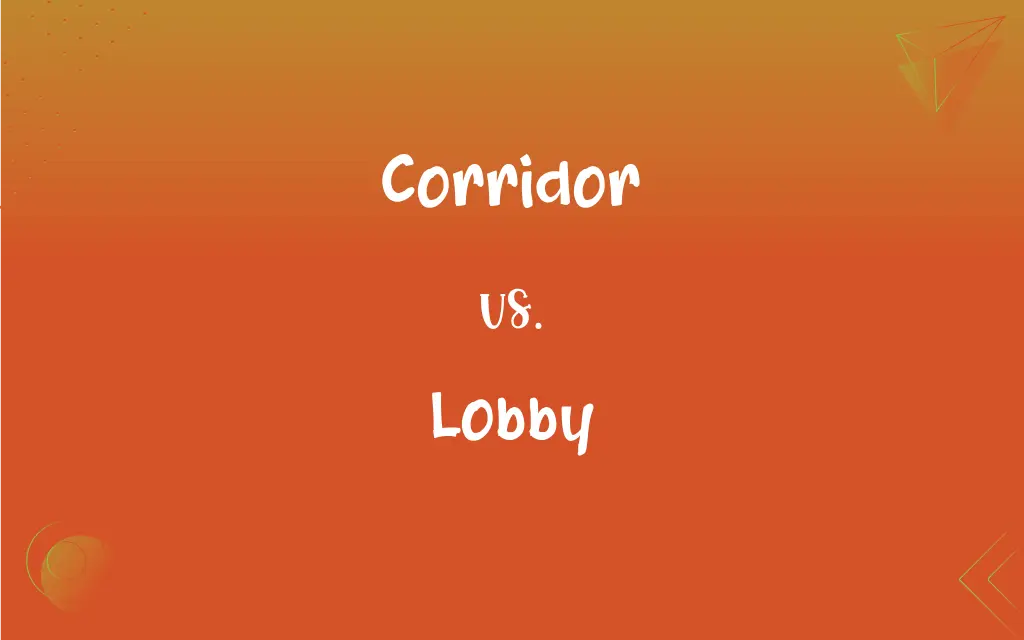Corridor vs. Lobby: What's the Difference?
Edited by Aimie Carlson || By Harlon Moss || Published on February 29, 2024
Corridor is a long, narrow passageway in a building connecting various rooms. Lobby is a large, open area inside the entrance of a building, often used as a waiting or gathering space.

Key Differences
A corridor is primarily a passageway or thoroughfare within a building, connecting different rooms or areas. It's designed for movement, not for staying. On the other hand, a lobby serves as a welcoming space or entrance hall in buildings, particularly hotels, office buildings, or theatres. It's often used as a waiting area and may include seating, reception desks, and artwork.
Corridors are usually narrower and longer, intended for transit, and are not typically used as gathering places. Their design is straightforward, focusing on facilitating movement from one area to another. Lobbies, in contrast, are generally spacious, designed to accommodate a larger number of people. They are often elaborately decorated, reflecting the building's character or the business's brand.
Corridors are found throughout a building, at various levels, leading to different rooms or sectors. They're an integral part of the internal layout. Lobbies are typically located at the main entrance of a building, serving as the initial point of entry for visitors.
The purpose of a corridor is utilitarian, facilitating efficient movement and access. Lobbies, however, often have multiple functions: they can be used for socializing, conducting informal business, waiting, or as a reception area.
In architectural design, corridors are essential for the internal flow and connectivity of a building. They are not usually the focus of architectural expression. Lobbies, conversely, are often architecturally significant, designed to make a statement or provide a specific atmosphere or experience for visitors.
ADVERTISEMENT
Comparison Chart
Primary Function
Passage connecting rooms or areas
Entry space and waiting area
Design Focus
Efficiency and connectivity
Spaciousness and welcoming atmosphere
Typical Location
Throughout a building, various levels
At the main entrance
Usage
Transit and access
Socializing, waiting, reception
Architectural Emphasis
Functionality and internal flow
Aesthetic appeal and first impression
ADVERTISEMENT
Corridor and Lobby Definitions
Corridor
A transitional area in a train or airplane between compartments.
She walked down the corridor of the train to find her seat.
Lobby
The act of trying to influence decision-makers in government or business.
They spent the afternoon lobbying for educational reform.
Corridor
A strip of natural habitat connecting wildlife populations.
This green corridor helps migratory birds navigate the city.
Lobby
A large entrance hall or reception area in a building.
Guests were welcomed in the grand lobby of the hotel.
Corridor
A narrow hallway in a building connecting various rooms.
The corridor led to a series of offices on the second floor.
Lobby
A waiting area in a building like an office or theatre.
The audience gathered in the lobby during the intermission.
Corridor
A route used for specific purposes like transportation or communication.
The shipping corridor is vital for international trade.
Lobby
A group that seeks to influence legislators on a specific issue.
The environmental lobby advocated for stricter pollution controls.
Corridor
An institutional or bureaucratic channel for communication or decision-making.
He navigated the corridors of power to get his policy approved.
Lobby
A vestibule or entrance hall in a large house.
The mansion's lobby was adorned with family portraits.
Corridor
A narrow hallway, passageway, or gallery, often with rooms or apartments opening onto it.
Lobby
A hall, foyer, or waiting room at or near the entrance to a building, such as a hotel or theater.
Corridor
A tract of land designated or used for a specific purpose, as for railroad lines, highways, or pipelines.
Lobby
A public room next to the assembly chamber of a legislative body.
FAQs
What is a corridor?
A corridor is a long, narrow passageway inside a building connecting different areas.
Do lobbies always have seating?
Most lobbies have seating, but it's not a strict requirement.
Is lighting important in corridors?
Yes, proper lighting is crucial in corridors for safety and navigation.
Do all office buildings have lobbies?
Most office buildings have lobbies, but small buildings might not.
What is a lobby?
A lobby is a large, open area at the entrance of a building, often used as a waiting or gathering space.
Can lobbies be used for events?
Yes, lobbies are often spacious and can be used for events, receptions, or exhibitions.
Are corridors always straight?
No, corridors can be straight, curved, or L-shaped, depending on the building's design.
What is the main purpose of a corridor?
The main purpose of a corridor is to provide a path for movement within a building.
Do lobbies need to be large?
Lobbies vary in size but are generally spacious to accommodate multiple people.
What materials are commonly used in corridor construction?
Common materials include drywall, tiles, and sometimes glass for windows.
Can a lobby be on a floor other than the ground floor?
It's uncommon, but some buildings have lobbies on higher floors.
Are lobbies important for first impressions in hotels?
Absolutely, lobbies in hotels are key to making a positive first impression on guests.
Are corridors considered architectural features?
Corridors are essential for function but are not usually highlighted as architectural features.
Are lobbies secure areas?
Lobbies can have security measures, but they are generally accessible to the public.
Are corridors only found indoors?
Typically, yes, but the term can also refer to outdoor pathways connecting buildings.
Is it common to have art in lobbies?
Yes, many lobbies display art to enhance their aesthetic appeal.
How are lobbies decorated?
Lobbies are often decorated to reflect the building's purpose and style.
Can corridors have windows?
Yes, some corridors have windows, though many do not.
Can lobbies be multi-functional?
Yes, lobbies can serve various purposes, from waiting areas to social spaces.
Can corridors be outdoor spaces?
Rarely, but the term can be used for covered outdoor walkways.
About Author
Written by
Harlon MossHarlon is a seasoned quality moderator and accomplished content writer for Difference Wiki. An alumnus of the prestigious University of California, he earned his degree in Computer Science. Leveraging his academic background, Harlon brings a meticulous and informed perspective to his work, ensuring content accuracy and excellence.
Edited by
Aimie CarlsonAimie Carlson, holding a master's degree in English literature, is a fervent English language enthusiast. She lends her writing talents to Difference Wiki, a prominent website that specializes in comparisons, offering readers insightful analyses that both captivate and inform.
































































